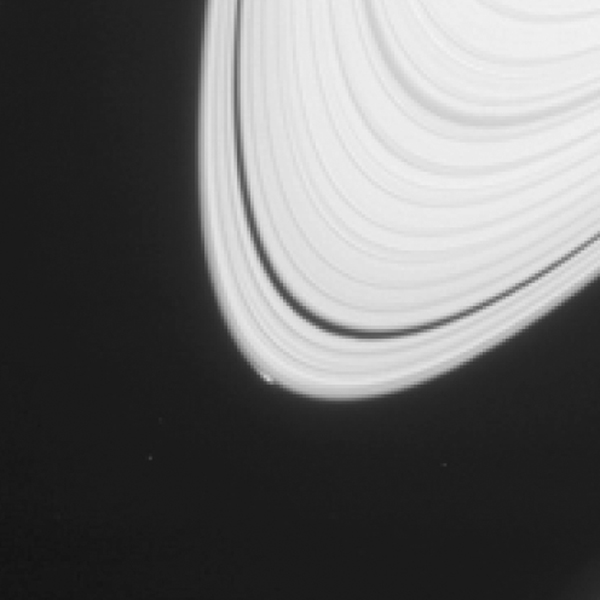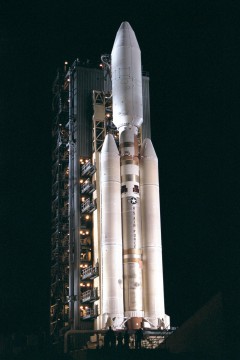
The Cassini spacecraft, a flagship-class mission that is a cooperative project between NASA, the European Space Agency (ESA), and the Italian Space Agency (ASI), may have uncovered the birth of an icy moon from within Saturn’s rings. This object was shown in an image Cassini took from its narrow angle camera (part of its Imaging Science Subsystem) of the gas giant’s “A” ring on April 15, 2013. The possible moon is described by NASA as being “20 percent brighter than its surroundings, 750 miles [1,200 kilometers] long and 6 miles [10 kilometers] wide.”
In addition, protuberances were seen on the object, which is unusual—Saturn’s rings are normally smooth. The moon has been christened “Peggy.” The findings were published online Monday, April 14, by the journal Icarus.
Scientists have theorized that the arc and protuberances could possibly be caused by a gravitational effect from a nearby object, such as a moon. Despite its small size and possible fleeting nature (NASA stated the moon is not expected to grow larger, and may be deteriorating), the presence of such an object appearing to migrate from a ring may shed historic light upon how Saturn’s larger icy moons (such as Titan and Enceladus) may have formed. Furthermore, this finding may illustrate how planets—including our own—may have formed.

This finding produced excitement on both sides of the ocean. Carl Murray of Queen Mary University of London, who is the lead author of the journal’s finding, discussed his feelings about the possible discovery of a new icy Saturn moon. “We have not seen anything like this before. We may be looking at the act of birth, where this object is just leaving the rings and heading off to be a moon in its own right,” he related.
It is believed that Peggy may be the last of the moons produced by Saturn’s rings; the gas giant may not have the capability of generating more moons. Murray underscored the once-in-a-lifetime situation scientists and researchers may have uncovered in witnessing the possible formation of a new moon. “The theory holds that Saturn long ago had a much more massive ring system capable of giving birth to larger moons. As the moons formed near the edge, they depleted the rings and evolved, so the ones that formed earliest are the largest and the farthest out.”
Linda Spilker, a Cassini project scientist at Jet Propulsion Laboratory (JPL), added, “Witnessing the possible birth of a tiny moon is an exciting, unexpected event.” Spilker said that Cassini’s orbit will take it closer to the planet’s A ring in late 2016, giving the spacecraft an opportunity to further study and possibly take images of Peggy.
This discovery is just one of the many firsts achieved by Cassini and the lander it launched with in 1997, Huygens. In early April, NASA and JPL reported that the spacecraft found evidence of an underground ocean of water on Enceladus, making it possible that the moon may be able to host extraterrestrial microbes. These findings were reported in a previous AmericaSpace article written by Paul Scott Anderson.
Going further back, in January 2005 Huygens became the first spacecraft to land on Titan, and it sent back historic images of the moon’s surface. Like its sister flagship-class missions—Galileo, Viking, and Voyager—Cassini continues to awe space watchers with its findings many years after its inception.
Want to keep up-to-date with all things space? Be sure to “Like” AmericaSpace on Facebook and follow us on Twitter: @AmericaSpace



